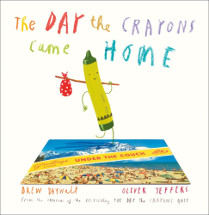The day the crayons came home by Drew Daywalt

Ill. by Oliver Jeffers. HarperCollins, 2015. ISBN 9780008124434 (Age: 4+) Highly recommended. Humour, Postcards, Travel, Inclusivity, Friendship, Caring for others. A gently humerous look at the crayons lost and forgotten around the house, brought to the attention of their owner by the rueful postcards sent to Duncan by each of the crayons. Each is a delight. Brief words, as befit a postcard, tell a harrowing story of what has happened to the luckless crayons; joined to a sock after being put in the wash, lost down the back of a couch, left in the hands of a younger sibling, or sharpened to oblivion. But each wants to come home, to be retrieved, to be with their owner, Duncan. A companion to the well loved The day the crayons quit (2014) this story is very funny, offering younger readers a tilt at differing forms of humour: irony (check out the brown crayon upset that everyone thinks he has a wonderful time drawing lovely things like chocolate), parody (the series of delightful travel postcards from Neon Red crayon), slapstick (Dad sitting on the crayon left on the couch), hyperbole (Pea Green's attempt to run away), Poo jokes (Brown crayon) and scary jokes (Glow in the dark crayon left in the cellar) and more. Each signing off on the postcards adds to the level of humour which younger readers will love, and the drawings by Oliver Jeffers will raise many laughs. All of his crayons ranging from Brown crayon, to Glow in the dark crayon, to Gold crayon are imbued with lives of their own. In a few deft blocks of colour, the personality of the crayon is exposed, underlined by the picture on their postcards. Younger readers will squeal with delight at the scenes of the traveling crayons, those stuck at home, those wanting to go out into the big world, those belonging to the younger member of the family. Each page is a visual and textual treat, giving readers lots to take in, to look at and discuss. Smaller drawings around the edges of the pages adds fun to the mix, and the end-papers will delight readers as will Duncan's solution to the problem of the returning but somewhat diminished crayons. He takes care of them all, even if Neon Red thinks he is climbing the Great Wall of China. I can imagine children in a class taking on the story of one of the crayons using what is told to them in the book, and expanding it to make a whole story. After they have finished laughing that is. Fran Knight